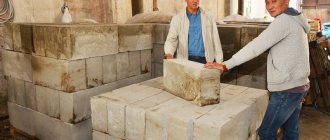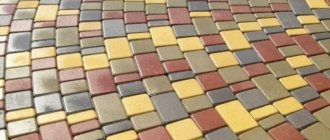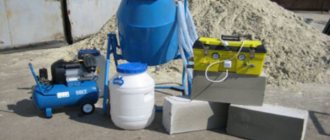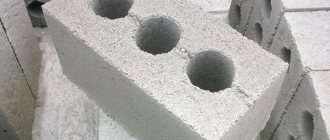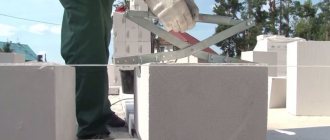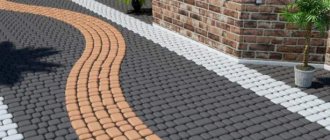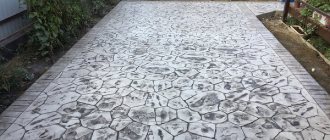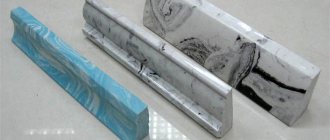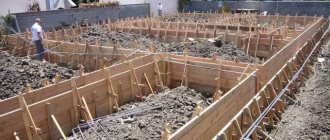Polished concrete is a modern version of the coating, which is created by grinding a concrete monolith to a shine and imitates cladding made of natural stones (marble, granite, slate, travertine, etc.). Using powerful grinding machines, you can achieve a perfectly smooth and sparkling surface yourself.
For grinding concrete, special tools are used that strengthen the composition. Polishing can be seen very often in public and industrial buildings in Europe and America. Gradually, the technology is becoming popular in the former CIS countries. A beautiful and practical coating has many advantages, which many craftsmen have already appreciated.
If you have a minimum of knowledge, tools and materials, you can do all the work yourself. The main thing is to comply with technology and safety regulations.
Application
Polishing concrete performs two functions at once - it makes the floor more beautiful and aesthetically pleasing, and also gives it certain properties. Thus, thanks to grinding, concrete becomes more durable, resistant to wear, sanitary and hygienic indicators are significantly improved, and the service life of the coating increases several times (when compared with concrete without grinding).
Polishing concrete with your own hands can be done in several ways, allowing you to achieve different effects - from matte (so-called satin) to sparkling glossy. Regardless of the effect, the treated surface becomes resistant to cracking and can be easily repaired if necessary.
Where polished concrete is most often created:
- In the pavilions of shopping centers
- At airports, train stations
- In a variety of cafes, business centers, exhibition complexes
- In the foyer, corridors of medical, educational institutions, administrations and reception areas
- In warehouses, workshops, and car parks, polished concrete can significantly reduce noise and vibration levels
- Coating in the premises of food industry enterprises, kindergartens, clinics and hospitals - concrete does not create dust, is easy and quick to clean
- In swimming pools, greenhouses, water parks and other rooms and structures with an aggressive environment - after all, polished concrete is not afraid of exposure to chemicals, humidity, and sudden temperature changes
- Where it is necessary to restore the old coating - in shopping malls, offices, public buildings
Concrete grinding technology is usually used where there is a high level of traffic and it is necessary to ensure maximum characteristics of strength, wear resistance, and durability of the coating.
It is still rare to see concrete of this type of treatment in apartments - only in spacious modern apartments, where such a choice is justified by the interior design.
Increasingly, in private housing you can see polished concrete as stair steps, plumbing fixtures, design structures, etc.
Equipment used
To sand the floor, hand-held power tools or specialized professional machines are used.
The choice depends on the area to be treated. As a rule, self-polishing of the floor is carried out in private houses or apartments where the areas are relatively small. Here you can limit yourself to a hand-held power tool, an angle grinder with a diamond wheel, or an electric drill with a special attachment.
However, specialized equipment is required to treat large areas.
As a rule, this is a complex that includes:
mosaic grinding machines
These are devices whose working body is rotating grinding discs. Experts call them “helicopters” due to some similarity of the rotating disks with the blades of an aircraft. If necessary, grinding discs can be replaced with polishing drums, which allows the use of one machine at all stages of processing;
industrial vacuum cleaners
They are connected to the MSM, or installed as independent suction units with catcher umbrellas;
water (mud) pumps
For removing water slurry saturated with grinding dust.
There are different designs of MSM. There are models with multiple rotors that have their own set of functions. The main indicator of such devices is the width of the passage, that is, the size of the processed strip.
In addition, the equipment differs by engine type - there are electrical equipment and devices with gasoline engines. They are more autonomous and can be used on a construction site. However, it is necessary to connect an exhaust hose to the exhaust pipe, otherwise you may suffocate in the room.
There are many offers on sale, but they all have a very high cost - purchasing one, not the most expensive set, will cost 200,000 rubles or more. For a one-time procedure of grinding and polishing the floor in an apartment or private house, this is too much expense. Even the simplest trowels cost about 50,000 rubles, which makes their use impractical.
The issue can be solved in another way - do not buy equipment for one-time use, but rent it for a few days. It will cost much less, but first of all you will have to find people or an organization willing to rent such kits. This is specialized equipment that is rarely allowed to sit idle - it is constantly in use.
Advantages and disadvantages
Before polishing concrete, it is advisable to study all the pros and cons of this method of floor treatment. 35 years of foreign experience in producing polished coatings allows us to form an opinion about all the features and nuances.
The main advantages of polished concrete:
- Increasing durability several times - having once made such floors, in the future it is enough to apply impregnation every 5-7 years and polish the surface again
- Increases mechanical strength up to 3 times
- Increased coating abrasion resistance by 54%
- Resistance to a variety of aggressive and chemical influences
- The ability to create a beautiful decorative surface that imitates natural stone cladding
- Significant reduction in the amount of dust in the room
- Simple and quick floor care
- Completely safe for health and environmentally friendly - concrete does not emit any resins, organic solvents, harmful fumes, etc.
- Maintaining the same level of vapor permeability, creating an optimal indoor microclimate
- Possibility of quick and easy restoration of polished concrete floors
- A chance to repair an old coating without pouring a new screed
- Relatively low cost of coverage
Polished surfaces create an ideal mirror surface, fitting perfectly into laconic modern interiors. Due to its aesthetics and excellent technical characteristics, polished concrete flooring is being chosen more and more often today. There are practically no disadvantages to this option - the work is carried out quickly, simply, with a minimum set of tools and materials.
Floor sanding cost per square meter
The cost of grinding is influenced by the condition of the surface, the processing method and the strength of the concrete being processed. For example, concrete grinding M300 will be about 20 rubles more expensive than other brands. However, it is worth considering that prices may vary from company to company.
Wet grinding will cost more, since the depth of processing is greater. You will have to pay the least for processing the cement screed, because... it is performed using the dry method. The strength of the screed is achieved in 5-7 days, and its polishing will cost 100 rubles per square meter.
The price of rough processing of cement screed is approximately 110 rubles. It is carried out using equipment with a fine-grained coating of the cutting material a month after pouring. The cost of finishing processing will cost 90 rubles. Finishing is most often performed using the wet method, so it is the most expensive - about 120 rubles.
To perform grinding you do not need to have any special skills. Anyone can do it, the main thing is to choose the right tool for the concrete being processed.
Technology
When wondering how to polish concrete, it is necessary to study all stages of the work.
Concrete polishing process:
- Testing the compressive strength of concrete (the indicator should be at least 20 MPa)
- Performing initial sanding
- Careful surface leveling, crack repair
- Cleaning the floor, removing dust and debris
- Application of impregnation to the surface
- High-quality sealing of pores and minimal defects using cement
- Grinding the top wet layer
- High-quality polishing after drying using special abrasive devices until the surface reaches the desired gloss level
- If desired (or necessary) – paint the floor with a colored hardener
- Coating concrete with finishing polish, various anti-slip compounds, etc.
It is allowed to polish old/new coatings. All impregnations penetrate directly into the material, increasing the hydrophobicity and density of its structure, removing dust before the main stage of work. Most often, compositions based on lithium silicates are chosen for these purposes - these can be Ultralit or LITSIL, Stain Protection.
Large areas of industrial premises, shopping malls, institutional lobbies, etc. It is advisable to grind with professional high-power machines.
At home, polishing can be done with a grinder - the process will be lengthy and the quality of the surface may be worse, but this option implies simplicity and accessibility.
Concrete laying
To save on concrete mix, it is recommended to lay the first layer of ordinary concrete. Plasticizers, crushed stone and quartz sand of different fractions can be left only for the top coating.
It is not necessary to level the concrete base for the first layer, but it is better to level the second layer. In this case, the thickness of the top coating must be at least 50 mm.
Milling, grinding and polishing are carried out only after the concrete has completely hardened and gained the required strength (after 28 days).
Tool
When polishing concrete, the technology involves the use of a special tool. In this case, we are talking about multi-stage abrasive processing of a concrete surface, performed using a mechanized method.
How to polish concrete:
- Planetary grinding raspberries - allow you to polish concrete to a mirror shine, eliminating the possibility of marks in the form of rings
- Traverse milling/sanding machines - quickly and efficiently remove the old layer, large irregularities, processing large areas
- Grinder - for processing small areas with your own hands, as well as any places with difficult access to them
Industrial vacuum cleaners are used to remove dust. The grinding process itself is carried out with special Frankfurts, pads, discs, cups with a grain size of 50-3000 grit.
For rough processing, diamond-coated attachments with a roughness index of about 50-120 grit are suitable; basic processing is performed with mechanisms with 200 grit. Polishing requires the use of parts with a grain size of 400-3000 grit. By choosing different elements, you can vary the level of polishing from matte to glossy.
Monolithic slab
A monolithic slab is the most reliable foundation.
It involves pouring and forming a monolithic concrete block with metal reinforcement inside. The specific design ensures the “buoyancy” of the entire structure. A garage built on a floating slab base is protected from changes in ground level and, accordingly, from destruction of the walls.
The slab base is shallow, but unlike tape, in this case the entire floor area is reinforced.
There are several types of monolithic foundation:
A continuous horizontal fill is arranged for rooms without a basement or plinth: the upper surface of the slab is the basis for laying the floor covering. A ribbed slab is poured along the perimeter of a monolithic strip (or as intersections), the height of such a ribbed fill is equal to the level of the plinth. Pouring a box means that the walls are continuation of the base, and have common reinforcement.
The height of the ribs is displayed at the floor level. Floor slabs are laid on top of the ribs. This method maximizes the area of load distribution.
Typically, the foundation slab is poured for garages in which it is not planned to install an inspection pit. But if the type of soil allows it, you can lower the filling level to the height of the basement or inspection hole and bring the ribs to the level of the soil surface, arranging an overlap over them.
Grinding methods
Concrete floors are polished using two main methods: dry and wet. The dry method is used more often; it is faster and does not require drying time. Dry grinding is carried out with large diamond fractions, which eliminate all errors. The only drawback of the method is the huge amount of dust, which only a vacuum cleaner can deal with.
The wet method is more expensive and is used less frequently. Most often, mosaic floors with marble chips are treated in this way. Grinding is carried out with powdered solid particles of various sizes or fine-grained ones.
Thanks to the difference in particles, it is possible to achieve a perfect mirror shine. The disadvantage of the process is that the surface gets wet, then it takes time to dry completely.
Creating the right coating for future sanding
Concrete of any grade can be grinded, but only if the main condition is met: the height of the unevenness should not exceed 5 millimeters. To make this rule easier to follow, before pouring a concrete floor, you need to take into account its purpose and choose the right materials.
For example, it is better to polish durable structures using concrete M300, and for warehouse premises – using concrete grade M150-M250. You can reduce the time spent on grinding by using marble chips.
Mechanized floor screed
Stages of work execution
To do everything correctly, you need to pay serious attention to studying the technology and perform all stages in the correct order. All work is carried out after the concrete has hardened (wet sludge can cause clogging of the cutting parts of the machine). An industrial vacuum cleaner must be connected to the work; upon completion of the work, the surface is dust-free.
How to polish concrete:
- Thorough cleaning of the surface - dirt, a layer of old coating, etc. are removed by shot blasting or milling.
- Accurate removal of defects - potholes, cracks, seams. Epoxy mastic is used to level concrete. It is necessary to remove all protrusions/irregularities so that the machine does not cling to them when polishing.
- Performing the first grinding - provided that the screed is smooth, this step can be skipped. Initial rough grinding is performed with 400 grit (37 micron) diamond discs.
- Chemical treatment of the screed with a hardener, which contains components that interact with calcium hydroxide in the solution. The structure of the monolith becomes more durable and strong. At the end of the stage, impregnation is applied.
- Final grinding and polishing is performed using discs with a grain size of at least 400 grit. To give the floor shine and gloss at the end of the polishing stage, polishing is done with diamond-coated discs with a grain size of 1500-3000 grit.
Chemical treatment
In order for the sanded surface to be as durable as possible, it must be coated with a hardener. The concrete monolith contains calcium hydroxide, which reacts with substances of this composition, thereby significantly increasing the strength characteristics and hardness of the base.
It is best to use the Xtreme Hard Densifier impregnator for this purpose. Its cost is 38,000 rubles for 19 liters. However, since this is a concentrate, it is diluted with water in a ratio of 1:4, respectively, the output is 95 liters of solution. If you are processing a small area, then you can purchase the KEMA Impregrant Powder hardener costing 13,500 rubles per 10 kg of powder concentrate.
After applying the impregnation, you can proceed to the final stage of work.
Errors
It is better to study all common mistakes and troubles before starting work. Having no idea how to polish concrete at home can only ruin everything.
The most common mistakes when polishing concrete:
- Performing operations not in a strictly specified sequence
- Polishing with a low-quality tool with incorrectly adjusted rotation speed and roughness levels
- Refusal to use special high-quality impregnations
- Reluctance to remove dust after each pass
- Processing of concrete class below B22.5
- Choosing insufficiently strong crushed stone as a filler
- Refusal to maintain technology - first of all, the duration of drying of impregnations
By following simple rules and the order of work, the master will be able to polish the concrete quickly and efficiently without any problems.
Preparation
In order for polished concrete to last a long time, its proper preparation plays an important role.
To do this, you need to take the following steps. First of all, dismantle the old coatings and check the evenness of the plane with a three-meter ruler. The presence of holes, potholes or bumps determines the degree of cup wear.
Then you need to examine the surface for the size of cracks, seams, etc. If available, seal them with any hand tool.
Before starting sanding work, you also need to tap the floor or walls for strength.
If it is missing, some areas will have to be refilled. At the same stage, complex work is performed, for example, diamond drilling of concrete
It is important to ensure the reliability of the power supply - any interruptions can have a detrimental effect on the outcome of the process
Important criteria in assessing the readiness of a floor for sanding are the absence of cracks, seams and other elements that could damage the delicate sanding tool.
DIY polishing
All concrete polishing work is carried out after the floor has completely hardened. For grinding you may need: a milling machine with elements made of hard alloys, a grinding machine with elements with corundum/diamond coating, an angle grinder, brushes with corundum coating, a respirator and goggles for protection.
First, the surface is cleaned of old coatings, dust and dirt, then all irregularities and defects are removed. If the damage is significant, it must be treated by deep milling. The waves will not go away (you will need to fill the screed for them), grooves will remain, which are removed by grinding.
Grinding removes the top layer of concrete that appears as a result of hardening of the laitance. It is the milk that prevents the sealant composition from entering the concrete structure, so a small layer is removed to expose the aggregate (crushed stone, granite chips, limestone, gravel). This should only be done after at least 2-3 weeks after pouring, when the concrete is already strong and holds the aggregate.
The type of cutting segments is chosen in accordance with the grade of concrete - for M250 and above, diamond coating is suitable, if the grade is lower, you can use corundum coating. But it is desirable that the grade of concrete for the floor be at least M300, otherwise it will not be possible to guarantee positive characteristics and high-quality processing.
If there is no special equipment, polishing is carried out with suitable metal brushes coated with corundum. Surfaces with protruding reinforcement parts are cut off with a grinder.
The sequence of work is the same as for professional polishing: first, the surface is cleaned of dirt and old coatings by shot blasting or milling, then cracks/potholes and all expansion and shrinkage joints are removed. Next, they roughly grind with diamond discs up to 400 grit, strengthen the layer with impregnation, grind again with discs with a grain of more than 400 grit, and finish everything with segments with a spray grain of up to 3000 grit.
Freestanding concrete screed
If the garage has already been built, but the interior work has not been carried out, you can install a concrete floor for the garage by pouring a rough screed over the ground. Logically, all work is carried out in the same order as when pouring the slab. The only difference is that instead of formwork, the pit is laid with waterproofing material.
What to lay at the bottom of the pit depends on the financial capabilities of the owners.
You can lay geotextiles, polyethylene film or roofing felt
It is important to secure the seams firmly and lay the material over the walls. As a result, you should get a kind of sealed bowl
The solution is poured to the level of the beacons, leveled, after setting slightly, the beacons are removed from the pouring and their locations are leveled. Walk over the surface of the screed with a needle roller to prevent the formation of voids and increase the strength of the screed. The quality of the screed is significantly influenced by the drying process of the solution. To prevent cracking, in addition to properly laid down waterproofing, it is worth covering the floor with plastic film after pouring. The floor will set for at least 72 hours. During this time, the floor should be regularly wetted and covered with film again.
If necessary, the drying time can be extended. Before you start installing a concrete floor in the garage with your own hands, correctly assess the initial natural data and your own strengths. In some cases, deviations from standard technologies are acceptable
It is important to correctly assess the risks and benefits obtained
The video in this article will show the installation of concrete floors in a garage with economical but effective insulation.
Safety regulations
Before polishing the concrete at home with your own hands, you need to carefully study all the safety rules, operating features of electrical equipment, and different types of equipment.
Things to remember:
- Before starting work, the tool and all components are checked for serviceability, availability of all parts, and readiness for grinding.
- The quality of fastening of segments (circle, bowl) is carefully checked
- The machine should run for a maximum of 15 minutes, then turn it off, wait for the temperature in the equipment to drop and continue
- You can only work in a special suit, glasses, gloves, etc. – this will allow you to perform tasks safely, without compromising the health and quality of the floor
- Worn elements, components, units, segments are replaced immediately
Polished concrete is modern, beautiful, aesthetically pleasing, hygienic and durable. Provided that all stages of the work are carried out correctly with a professional tool, you can be sure that the floor will be perfectly glossy and surprisingly durable.
Leveling screed
This procedure is carried out on most types of floors, concrete is no exception. However, for a garage floor, a leveling screed is not a prerequisite.
Often, the evenness of the surface obtained with regular rough filling is sufficient. Sometimes the finishing floor covering is made using dense sheet materials such as porcelain tiles, tiles or rubber tiles.
And the floor is finally leveled at the stage of their installation. You can read about the procedure for finishing floor leveling: how to properly make a finishing screed and the best way to cover a concrete floor in a separate article with a detailed description of the work technology.
Required Properties
Concrete for flooring must first of all have a grade strength of at least B22.5, be well vibrated and troweled, and have any filler except limestone. An important condition is the time that has passed since the concrete foundation was laid. It should be about twenty-eight days, no less.
Other conditions will primarily affect the speed of work completion:
- the concrete undergoes a leveling operation to eliminate differences;
- such coatings can be restored to smooth out chips or cavities;
- old concrete floors can be partially restored.
But such operations require additional financial costs and free time. Only by observing the above properties can one achieve high quality of a material such as polished concrete. The floor, if all requirements are met, will differ from other coatings in durability and aesthetic appeal at low cost. Of course, you can use alternative materials: decorative polymer concrete, which does not require a screed size of ten centimeters, or reinforcement, if you do not want to carry out a lot of mechanical work. But then the final price tag of such floors will increase.
Consumables for angle grinders
There are several types of attachments for concrete grinding:
- Cups. They are discs with a recessed center. The purpose depends on the shape of the working surface:
- with square pads - for roughing with cutting off protruding fragments of concrete;
- with a double segment - for uniform removal of the top layer;
- with boomerang-shaped pads - for final surface polishing.
- Discs (circles). They have a flat surface with an abrasive applied to it:
- with large and medium-sized diamond chips - for rough grinding;
- with fine crumbs and a cellular structure (turtles) - for polishing.
- Frankfurt. Special trapezoidal nozzles. Depending on the type and characteristics of the working surface, they are used for grinding or polishing concrete floors.
Mixtures for the production of polished surfaces
First of all, the concrete floor must meet the strength class B25, which is easy to achieve if you use Portland cement of a grade no lower than M350 with low water consumption. The situation with fillers is much more complicated. As a rule, crushed stone obtained by crushing rocks (for example, basalt or diorite) is used to prepare such mixtures. This type of filler is characterized by increased compressive and tensile strength (when compared with a cement monolith). Due to this discrepancy in characteristics, during operation of the base, the areas around the filler grains will wear out to a greater extent. As a result, the polished concrete floor will lose its smoothness and after a few years, bumps will form on it.
In order to avoid such defects, it is necessary to take into account the following nuances when selecting the composition for arranging the base:
- The more high-strength filler in the solution, the better. In this case, it is worth giving preference to crushed stone, which should occupy at least 85% of the total mass of the mortar.
- It is best if crushed stone of different sizes is used for the mixture, then the solution will be much denser. The best option is to mix two different fractions of quartz sand and several gravel components in equal parts. However, grains that are too large (more than 20 mm in size) should not be used.
It is best to prepare mixtures for subsequent grinding and polishing in a forced-action concrete mixer. When the solution is homogeneous, you can proceed to pouring it.
